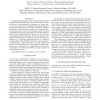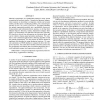184 search results - page 33 / 37 » Introduction of the Speaking Rate in the Model of Speech Rec... |
ICPR
2006
IEEE
14 years 8 months ago
2006
IEEE
Coarticulation is one of the important factors that makes automatic sign language recognition a hard problem. Unlike in speech recognition, coarticulation effects in sign language...
HRI
2006
ACM
14 years 1 months ago
2006
ACM
We present a method of grounded word learning that is powerful enough to learn the meanings of first and second person pronouns. The model uses the understood words in an utteran...
ICASSP
2011
IEEE
12 years 11 months ago
2011
IEEE
Exemplar-based techniques, such as k-nearest neighbors (kNNs) and Sparse Representations (SRs), can be used to model a test sample from a few training points in a dictionary set. ...
ICASSP
2008
IEEE
14 years 2 months ago
2008
IEEE
Phoneme segmentation is a fundamental problem in many speech recognition and synthesis studies. Unsupervised phoneme segmentation assumes no knowledge on linguistic contents and a...
EMNLP
2008
13 years 9 months ago
2008
Predicting possible code-switching points can help develop more accurate methods for automatically processing mixed-language text, such as multilingual language models for speech ...


